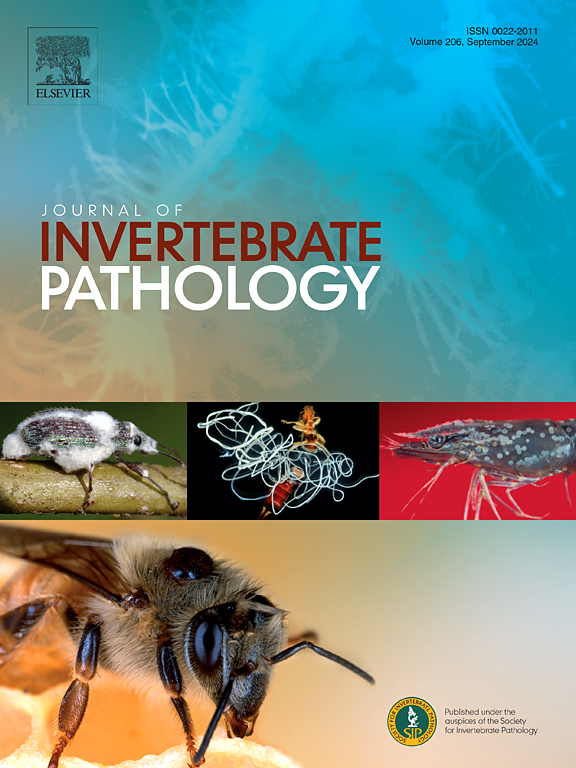Partial ecological niche partitioning between Beauveria brongniartii and Beauveria pseudobassiana entomopathogens at Melolontha melolontha infested sites
IF 2.4
3区 生物学
Q1 ZOOLOGY
引用次数: 0
Abstract
Beauveria brongniartii specifically infects the insect pest Melolontha melolontha and is commonly isolated from soil and larvae. Since 1990, it has been used commercially as a biological control agent (BCA) against the larvae. Recent research revealed that B. pseudobassiana was the most frequently isolated pathogen from adult beetles collected aboveground across 35 alpine sites. This led us to hypothesize that B. pseudobassiana primarily infects adults aboveground, while B. brongniartii mainly targets larvae in soil. To test these hypotheses, we investigated the occurrence and distribution of both species at two M. melolontha-infested sites in Switzerland using a combination of phylogenetic analyses and microsatellite markers. Species-specific microsatellite markers were developed for B. pseudobassiana, and existing markers were applied to B. brongniartii. From 399 Beauveria spp. isolates collected from adult beetles, soil, grassland plants, and tree leaves, 362 were identified as B. brongniartii, which was present in all sources except tree leaves, and 37 as B. pseudobassiana, found in all sources including tree leaves, except soil. The most common B. brongniartii multilocus genotypes (MLGs) were those of the BCAs BIPESCO 2 and BIPESCO 4, perhaps reflecting previous BCA applications at these locations. One B. pseudobassiana microsatellite-based MLG was isolated from both tree leaves and M. melolontha in the tree canopy. Additionally, B. pseudobassiana isolated from the phylloplane exhibited pathogenicity toward M. melolontha adults, suggesting the possibility of acquiring infections aboveground. To detail B. pseudobassiana intraspecific diversity, a sequence dataset was constructed including 13 unique haplotypes of the nuclear intergenic region Bloc sequenced in this study, 58 Bloc sequences downloaded from GenBank, and sphyngomyelin phosphodiesterase, glycosyl hydrolase, and AAA-ATPase midasin I sequences from 18 isolates illustrative of B. pseudobassiana genome diversity accessioned in GenBank. Phylogenetic analysis of this data reveals the species to comprise a cryptic complex with distinct genetic clusters that group isolates independently of their geographic origin and isolation substrate. Overall, this study shows B. brongniartii predominates in soil, while B. pseudobassiana occurs in the phylloplane, suggesting its potential as a complementary biological control for adult beetles aboveground.

白僵菌与假球孢白僵菌侵染地部分生态位划分。
长绒白僵菌是一种专门感染害虫的真菌,通常从土壤和幼虫中分离出来。自1990年以来,它已作为一种生物防治剂(BCA)用于商业上的幼虫。最近的研究表明,在35个高山地点采集的成年甲虫中,假球孢白僵菌是最常见的病原体。由此推测,假球孢白僵菌主要侵染地面上的成虫,而布氏白僵菌主要侵染土壤中的幼虫。为了验证这些假设,我们使用系统发育分析和微卫星标记相结合的方法调查了瑞士两个M. melolontha侵染地点这两个物种的发生和分布。为假球孢白僵菌开发了物种特异性微卫星标记,并将已有的标记应用于长毛螺旋体。从成虫、土壤、草地植物和树叶中分离得到的399株白僵菌分离株中,362株为除树叶外所有来源的棕螺旋体分离株,37株为除土壤外所有来源的假球孢白僵菌分离株。最常见的长鼻螺旋体多位点基因型(mlg)是BCA BIPESCO 2和BIPESCO 4的基因型,这可能反映了BCA在这些地区的应用。从树木叶片和冠层中分离到1个基于假球孢微卫星的MLG。此外,从叶面分离的假球孢白僵菌对甜瓜蚜成虫具有致病性,提示有可能在地上感染。为了详细描述假球孢白白菌的种内多样性,我们构建了一个序列数据集,包括本研究测序的13个核基因间区单倍型的Bloc序列,从GenBank下载的58个Bloc序列,以及从GenBank中加入的18株假球孢白白菌基因组多样性的sphyngomyelin磷酸二酯酶、糖基水解酶和aaa - atp酶midasin I序列。对这些数据的系统发育分析表明,该物种包含一个具有不同遗传簇的隐式复合体,这些遗传簇独立于其地理起源和分离基质。总体而言,本研究表明,褐飞虱在土壤中占主导地位,而假球孢飞虱则发生在层状面,这表明其在地面上作为成虫的补充生物防治潜力。
本文章由计算机程序翻译,如有差异,请以英文原文为准。
求助全文
约1分钟内获得全文
求助全文
来源期刊
CiteScore
6.10
自引率
5.90%
发文量
94
审稿时长
1 months
期刊介绍:
The Journal of Invertebrate Pathology presents original research articles and notes on the induction and pathogenesis of diseases of invertebrates, including the suppression of diseases in beneficial species, and the use of diseases in controlling undesirable species. In addition, the journal publishes the results of physiological, morphological, genetic, immunological and ecological studies as related to the etiologic agents of diseases of invertebrates.
The Journal of Invertebrate Pathology is the adopted journal of the Society for Invertebrate Pathology, and is available to SIP members at a special reduced price.

 求助内容:
求助内容: 应助结果提醒方式:
应助结果提醒方式:


